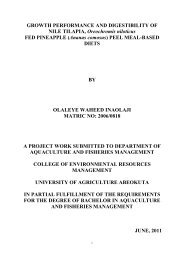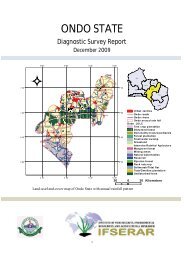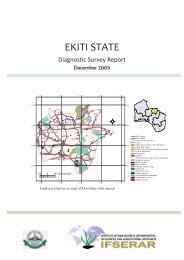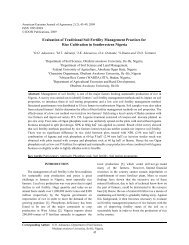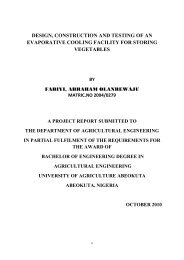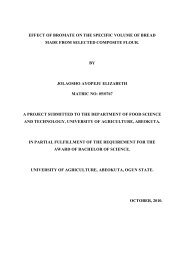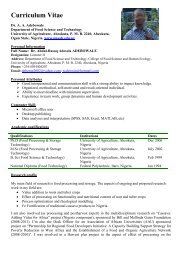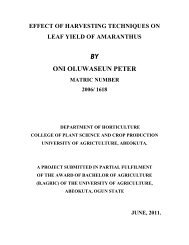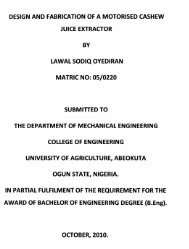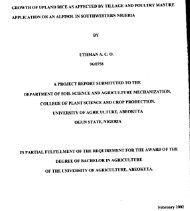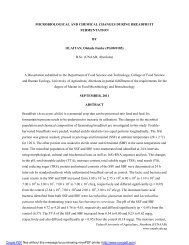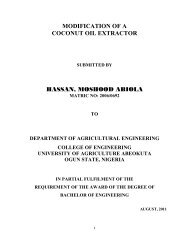presence of aflatoxins in smoked-dried fish sold in abeokuta, ogun ...
presence of aflatoxins in smoked-dried fish sold in abeokuta, ogun ...
presence of aflatoxins in smoked-dried fish sold in abeokuta, ogun ...
Create successful ePaper yourself
Turn your PDF publications into a flip-book with our unique Google optimized e-Paper software.
Analyses <strong>of</strong> breast milk <strong>in</strong> Ghana, Nigeria, Sierra Leone and Sudan showed primarily aflatox<strong>in</strong><br />
M1, aflatox<strong>in</strong> M2 and aflatoxicol. Aflatox<strong>in</strong> exposure pre- or post-natally at levels ≥ 100 µg/l<br />
was very <strong>of</strong>ten associated with illness <strong>in</strong> the child (Maxwell, 2008). Exposure <strong>of</strong> <strong>in</strong>fants to<br />
aflatox<strong>in</strong> M1 from mothers’ breast milk <strong>in</strong> the United Arab Emirates has been measured by Saad<br />
et al. (1995). Among 445 donors <strong>of</strong> breast milk, 99.5% <strong>of</strong> samples conta<strong>in</strong>ed aflatox<strong>in</strong> M1 at<br />
concentrations rang<strong>in</strong>g from 2–3 µg/l. The mothers were <strong>of</strong> a wide range <strong>of</strong> nationalities, ages<br />
and health status; no correlation was observed between these factors and aflatox<strong>in</strong> M1 content <strong>of</strong><br />
the milk.<br />
2.6 Absorption, Metabolism and Excretion <strong>in</strong> Humans<br />
Rigorous quantitative comparisons <strong>of</strong> dietary <strong>in</strong>takes and aflatox<strong>in</strong> metabolites <strong>in</strong> body fluids<br />
follow<strong>in</strong>g absorption and distribution are lack<strong>in</strong>g, aflatox<strong>in</strong> M1 concentrations <strong>in</strong> ur<strong>in</strong>e and<br />
human milk have been correlated with dietary aflatox<strong>in</strong> <strong>in</strong>take. However, studies <strong>of</strong> human<br />
exposure have yielded quantitatively very different correlations between aflatox<strong>in</strong> concentrations<br />
<strong>in</strong> foods and either aflatox<strong>in</strong>–prote<strong>in</strong> or aflatox<strong>in</strong>–DNA adducts <strong>in</strong> ur<strong>in</strong>e and sera (Hall et al.,,<br />
1994). Hudson et al. (1992) very carefully measured aflatox<strong>in</strong> <strong>in</strong>take based on plate foods <strong>in</strong> a<br />
village <strong>in</strong> The Gambia. They found <strong>in</strong>takes less than those estimated from aflatox<strong>in</strong>–serum and<br />
ur<strong>in</strong>ary adduct levels <strong>in</strong> the same <strong>in</strong>dividuals. In humans, as with other species, the DNA b<strong>in</strong>d<strong>in</strong>g<br />
and carc<strong>in</strong>ogenicity <strong>of</strong> aflatox<strong>in</strong> B1 result from its conversion to the 8,9-epoxide by cytochrome<br />
P450 (CYP) enzymes (Essigman et al., 2002). There is <strong>in</strong>dividual variability <strong>in</strong> the rate <strong>of</strong><br />
activation <strong>of</strong> aflatox<strong>in</strong>, <strong>in</strong>clud<strong>in</strong>g between children and adults, which may be material to the<br />
pharmacok<strong>in</strong>etics (Wild et al., 2001). The pharmacok<strong>in</strong>etics <strong>of</strong> <strong>aflatox<strong>in</strong>s</strong> <strong>in</strong> humans are still not<br />
clearly known.<br />
Factors that expla<strong>in</strong> variation <strong>in</strong> response to aflatox<strong>in</strong> between <strong>in</strong>dividual humans, animal species<br />
and stra<strong>in</strong>s <strong>in</strong>clude the proportion <strong>of</strong> aflatox<strong>in</strong> metabolized to the 8,9- epoxide (ma<strong>in</strong>ly by CYP<br />
enzymes) relative to the other much less toxic metabolites and the prevalence <strong>of</strong> pathways<br />
form<strong>in</strong>g non-toxic conjugates with reduced mutagenicity and cytotoxicity. The metabolism <strong>of</strong><br />
<strong>aflatox<strong>in</strong>s</strong> <strong>in</strong> humans has been extensively studied and the major CYP enzymes <strong>in</strong>volved have<br />
been identified as CYP1A2 and CYP3A4 (Gallagher et al., 1998). CYP3A4 mediates formation<br />
<strong>of</strong> the exo-epoxide and aflatox<strong>in</strong> Q1 while CYP1A2 can generate some exo-epoxide but also a<br />
15



